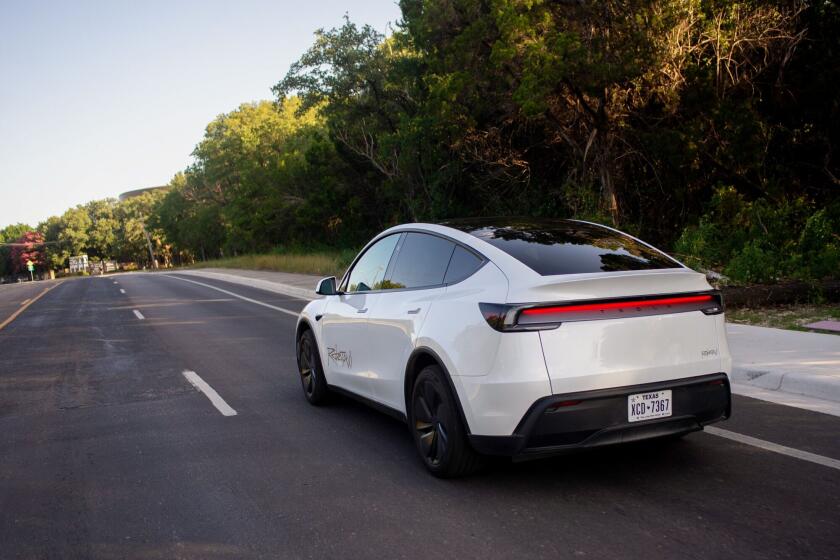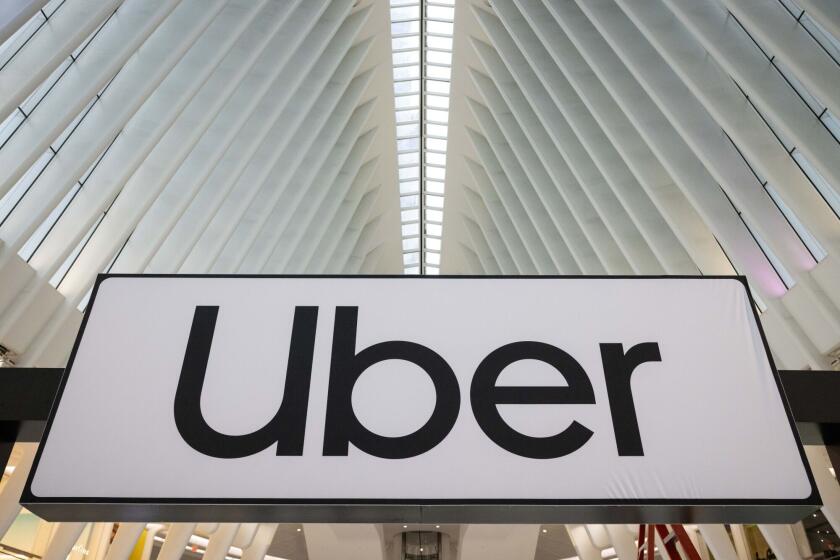Metrolink to Cut Travel Time Between High Desert, L.A. : Transit: Improvements to the track line are designed to cut about 30% off the commute by July 1.
- Share via
Metrolink officials provided a tour Monday of earthquake-related improvements to the track on the Santa Clarita line that are designed to cut about 30% off commuting times between the Antelope Valley and Los Angeles by July 1.
Crews are straightening many of the 50 curves on the commuter rail line between the Santa Clarita and Antelope valleys, allowing the average traveling speed to increase 35 to 45 m.p.h., said San Bernardino County Supervisor Larry Walker, who chairs the Metrolink Board of Directors.
The 78-mile trip from Lancaster to Los Angeles, which took two hours and 25 minutes when the line opened Jan. 24, will take an hour and 48 minutes when work is completed.
“That’s the same time as driving a car that distance during rush hour,” he said during a news conference Monday at the Via Princessa Metrolink station in Canyon Country.
The line between Santa Clarita and Lancaster did not exist before the Jan. 17 earthquake and was not scheduled for completion for at least 10 years. But the Federal Emergency Management Agency provided $50 million in emergency funds for the extension after the 6.8-magnitude temblor collapsed a connector ramp on the Antelope Valley Freeway, the only major highway route between the Antelope Valley and Los Angeles.
An existing rail line used for freight trains was converted to Metrolink use after the earthquake, but was operated more slowly than other Metrolink lines because of the numerous sharp curves, Walker said.
New tracks are being laid parallel to much of the old route, with straightaways and gentle curves replacing the older track’s multitude of sharp curves and allowing the train to run at speeds of up to 70 m.p.h.
In addition, more durable concrete ties are being used instead of the wood ties on the original track, and the traditional railing is being replaced by a continuously welded rail that provides a smoother ride.
At the news conference, Los Angeles County Supervisor Mike Antonovich and KNX-AM traffic reporter Jim Thornton touted improvements completed May 2 that cut the commute to two hours, seven minutes. A high-publicity campaign is planned to attempt to retain riders who have been using the train since the quake.
“You never hear me talking about a SigAlert that’s going to affect traffic on Metrolink,” Thornton said. There were 950 riders on the Santa Clarita line the Friday before the earthquake, according to Metrolink statistics. A peak of 11,000 riders rode Jan. 25 and about 6,000 people used the line on May 2.
A ridership study in March indicated that of the Santa Clarita and Antelope Valley passengers, 83% were boarding at two stations in the Santa Clarita Valley, said Peter Hidalgo, a Metrolink spokesman. He said recent figures indicate that stations in Acton, Palmdale and Lancaster are each attracting 100 to 200 passengers daily.
Santa Clarita City Councilwoman Jan Heidt said extending and repairing the line is cheaper than expanding freeway service, but the challenge is convincing people to ride the trains.
“Fifty million dollars is a tremendous investment in this line and we need to justify that with ridership,” she said.
Walker said the daily total ridership of the five Metrolink lines is about 18,000, compared to just under 10,000 before the earthquake. He said Metrolink officials hope to permanently retain 30% to 40% of the riders who began using the line after the earthquake.
Metrolink officials had projected a month after the earthquake that about 10% of passengers riding because of the disaster would become permanent, based on commuter rail ridership figures in San Francisco after the Loma Prieta quake in 1989, Hidalgo said.
He said current ridership figures far exceed expectations, but acknowledged that those are likely to go down during the next few months when repairs to the Golden State Freeway and parts of the Antelope Valley Freeway are completed.
Improving the speed of the Santa Clarita line is the key to persuading commuters to leave their cars at home, Hidalgo said.
“We want to make sure Metrolink is the fastest way in and out of the valley,” he said.
A discount on monthly passes is being offered to riders through June. Passes between the Antelope Valley and Burbank have been reduced from $176 to $80, and passes to Los Angeles have been reduced from $208 to $112.
More to Read
Sign up for Essential California
The most important California stories and recommendations in your inbox every morning.
You may occasionally receive promotional content from the Los Angeles Times.













